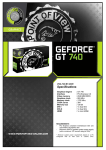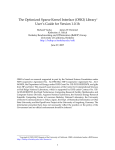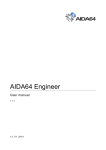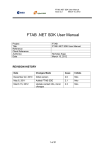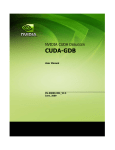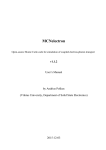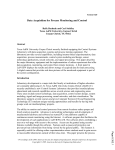Download 1 of 31 Cudafy User Manual 1.1 Project Cudafy Title Cudafy User
Transcript
Cudafy User Manual 1.1
Project
Cudafy
Title
Cudafy User Manual
Reference
Client Reference
Author(s)
Nicholas Kopp, Hybrid DSP Systems
Date
March 29, 2011
1 of 31
Cudafy User Manual 1.1
Revision History
Date
Changes Made
Issue
Initials
March 17, 2011
Support to Cudafy V0.3. First public
release.
0.3
Nko
March 29, 2011
Update for .NET Reflector Wrapper
1.0
Nko
May 22, 2011
Remove CudafyReflectorWrapper, .NET
Reflector Add-in; add CudafyTranslator
(based on ILSpy)
1.1
Nko
2 of 31
Cudafy User Manual 1.1
Hybrid DSP Systems
Email: info @ hybriddsp . com
Web: www.hybriddsp.com
© Copyright 2011 - Hybrid DSP Systems
3 of 31
Cudafy User Manual 1.1
Revision History .................................................................................................................................................... 2
Introduction ............................................................................................................................................................ 6
General Cudafy Process ................................................................................................................................ 6
Prerequisites .................................................................................................................................................... 7
Supported Operating Systems + Software configurations .................................................................... 7
Supported HARDWARE ............................................................................................................................ 7
Development Requirements ...................................................................................................................... 7
Recommended tools .................................................................................................................................. 8
Recommended SET-UP ............................................................................................................................ 8
Installation ............................................................................................................................................................. 9
Cudafy SDK ...................................................................................................................................................... 9
Cudafy By Example............................................................................................................................................ 11
hello_world...................................................................................................................................................... 12
simple_kernel ................................................................................................................................................. 12
simple_kernel_params .................................................................................................................................. 13
Enum_gpu ...................................................................................................................................................... 14
add_loop_cpu ................................................................................................................................................. 14
add_loop_gpu ................................................................................................................................................ 14
add_loop_gpu_alt .......................................................................................................................................... 15
add_loop_long................................................................................................................................................ 15
julia_cpu and julia_gpu ................................................................................................................................. 16
add_loop_blocks and add_loop_long_blocks ........................................................................................... 16
dot .................................................................................................................................................................... 16
ripple ................................................................................................................................................................ 17
ray and ray_noconst ...................................................................................................................................... 17
hist_gpu_shmem_atomics............................................................................................................................ 19
4 of 31
Cudafy User Manual 1.1
basic_double_stream_correct...................................................................................................................... 19
copy_timed ..................................................................................................................................................... 20
Cudafy Examples ............................................................................................................................................... 21
Array Basic Indexing ..................................................................................................................................... 21
Array Multi Dimensions ................................................................................................................................. 22
Global Arrays .................................................................................................................................................. 22
Complex Numbers ......................................................................................................................................... 22
Dummy Functions .......................................................................................................................................... 22
Using the Cudafy TRANSLATOR ............................................................................................................... 24
Improving Performance by Caching Cudafy Modules .............................................................................. 25
Cudafy Module Viewer ...................................................................................................................................... 26
Functions ........................................................................................................................................................ 27
Types ............................................................................................................................................................... 27
Constants ........................................................................................................................................................ 29
Generated Source Code ............................................................................................................................... 30
PTX .................................................................................................................................................................. 31
5 of 31
Cudafy User Manual 1.1
INTRODUCTION
Cudafy is a set of libraries and tools that permit general purpose programming of NVIDIA CUDA Graphics
Processing Units (GPUs) from the Microsoft .NET framework. Its aim is to be the leading set of tools for this
task; combining flexibility, performance and ease of use.
The Cudafy SDK comprises one library (DLL) called Cudafy.NET.dll and a Cudafy Module Viewer GUI. From a
high level it offers the following:
•
Cudafy .NET Library
o
Cudafy Translator (Convert .NET code to CUDA C)
o
Cudafy Library (CUDA support for .NET)
o
Cudafy Host (Host GPU wrapper)
o
Cudafy Math (FFT + BLAS)
•
Cudafy by Example demo projects
•
Cudafy Examples demo projects
•
Cudafy Module Viewer
The Translator converts .NET code into CUDA code. It is based on ILSpy – a very useful decompilation tool from
SharpDevelop. Its use as part of your daily .NET development is recommended.
http://wiki.sharpdevelop.net/ilspy.ashx
As a developer you will also require the NVIDIA CUDA Toolkit. Cudafy supports version 3.2 and 4.0. You can
obtain this from: http://developer.nvidia.com/object/cuda_3_2_downloads.html
Drivers supporting CUDA 4.0 or later are required. If you update your NVIDIA drivers you will get this
automatically.
It is highly recommended that the user first learns the basics of CUDA. The NVIDIA website is a good starting
point as is the book CUDA by Example by Sanders and Kandrot.
GENERAL CUDAFY PROCESS
There are two main components to the Cudafy SDK:
•
Translation from .NET to CUDA C and compiling using NVIDIA compiler (this results in a Cudafy module
xml file)
•
Loading Cudafy modules and communicating with GPU from host
It is not necessary for the target machine to perform the first step above.
6 of 31
Cudafy User Manual 1.1
1.
Add references to Cudafy.NET.dll from your .NET project
2.
Add the Cudafy, Cudafy.Host and Cudafy.Translator namespaces to source files (using in C#)
3.
Add a parameter of GThread type to GPU functions and use it to access thread, block and grid
information as well as specialist synchronization and local shared memory features.
4.
Place a Cudafy attribute on the functions.
5.
In your host code before using the GPU functions call Cudafy.Translator.Cudafy( ). This returns a
Cudafy Module instance.
6.
Load the module into a GPGPU instance. The GPGPU type allows you to interact seamlessly with the
GPU from your .NET code.
PREREQUISITES
SUPPORTED OPERATING SYSTEMS + SOFTWARE CONFIGURATIONS
Windows XP SP3
Windows Vista
Windows 7
Both 32-bit / 64-bit OS versions are supported.
Cudafy is built against Microsoft .NET Framework 4.0.
NVIDIA Drivers supporting CUDA 4.0 (NVCUDA.dll).
Cudafy FFT library requires CUFFT 3.2 or 4.0
Cudafy BLAS library requires CUBLAS 3.2 (4.0 not currently supported)
Cudart libraries for CUFFT or CUBLAS
SUPPORTED HARDWARE
All NVIDIA CUDA capable GPUs with compute capability 1.2 or higher are supported. Note that some language
features may not available in earlier versions of CUDA.
DEVELOPMENT REQUIREMENTS
The following is required when developing with Cudafy or if the application will perform translation of .NET
code to CUDA C and compilation:
7 of 31
Cudafy User Manual 1.1
•
NVIDIA CUDA Toolkit 3.2 or higher
•
Microsoft VC++ Compiler (used by NVIDIA CUDA Compiler)
These are not included in the Cudafy download must be downloaded separately.
RECOMMENDED TOOLS
Although not necessary the use of Visual Studio 2010 Professional is recommended. For 32-bit applications
Visual Studio Express can be used. NVIDIA Parallel NSight may be installed.
Although Cudafy simplifies the use of CUDA a basic understanding of CUDA is essential especially in terms of
architecture (threads, blocks, grids, synchronization). There are various websites with useful information and
the book CUDA BY EXAMPLE (Sanders and Kandrot) is highly recommended (many of the Cudafy examples
included in the SDK are direct .NET versions of the code in this book).
RECOMMENDED SET-UP
PC SPECIFICATION
To make use of the built in emulation that Cudafy offers, you will ideally be using a recent multi-core AMD or
Intel processor. Emulation of blocks containing thousands of threads is very inefficient for CPUs due to the
massive thread management overhead.
GRAPHICS CARD
The introduction by NVIDIA of the Fermi architecture (compute capability 2.x) brings a significant advancement
in terms of programming features and performance. Fermi allows better performance with less tuning of GPU
code. Although Cudafy supports compute capability from 1.2 the focus is on supporting Fermi and therefore
we recommend using it where possible. A good value card would be a GT460 or GT560.
SOFTWARE
Ideally you will have:
Windows 7 64-bit
Visual Studio 2010 Professional
CUDA 4.0 SDK
8 of 31
Cudafy User Manual 1.1
INSTALLATION
CUDAFY SDK
The Cudafy SDK is available as a zip file from www.hybriddsp.com. Unzip to a convenient location.
The contents of the bin directory is summarized below:
File
Description
CUDA.NET.Readme.txt
Release notes for CUDA.NET
Cudafy.NET.dll
Key library.
Cudafy.NET.xml
Code insight information.
CudafyModuleViewer.exe
A viewing tool for Cudafy modules.
ICSharpCode.Decompiler.dll
Third-party library from SharpDevelop (minor
changes to scope of some classes)
ICSharpCode.NRefactory.dll
Third-party library from SharpDevelop (minor
changes to scope of some classes)
ILSpy.dll
Third-party library from SharpDevelop (converted
into a library and AvalonEdit and TreeView
dependencies removed)
9 of 31
Cudafy User Manual 1.1
ILSpy-License.txt
ILSpy license (MIT)
Mono.Cecil.dll
By J B Evian (MIT)
The root directory also contains:
Directory
Description
CudafyByExample
This is a Visual Studio 2010 solution containing a
project that demonstrates many of the features of
Cudafy. The examples are based on the book CUDA
BY EXAMPLE (Sanders and Kandrot). A copy of this
book is highly recommended.
CudafyExamples
Another Visual Studio 2010 solution demonstrating
Cudafy features not covered in CudafyByExample.
These include dummy functions, complex numbers
and multi dimensional arrays.
Cudafy-License.txt
License agreement.
README.txt
Release notes.
Short cut to the on-line documentation
Html documentation and this user guide.
10 of 31
Cudafy User Manual 1.1
CUDAFY BY EXAMPLE
The quickest way to get up and running with Cudafy is to take a look at the example projects. These can be
found in the Samples sub-directory of the SDK. You may wish to make a copy of these directories before you
begin building and modifying them – if so bear in mind that if you open the copies then the reference to
Cudafy.NET.dll may be broken if the relative path is different. This dll is in the bin directory so re-add it if
necessary.
Navigate to CudafyByExample. If you have Visual Studio 2010 installed you can simply click the solution file
(*.sln). You will soon see something like this:
The folders chapter03 through chapter10 refer to the chapters of the book CUDA BY EXAMPLE (Sanders and
Kandrot).
11 of 31
Cudafy User Manual 1.1
Open the file Program.cs. Since this is a Console application this is the code that will run when you run it. The
static CudafyModes class is a helper for storing our code generation and target settings so all examples can
access them. Basically we set the code generation to CUDA C and the target to a CUDA GPU. You can also set
to Emulator but it’s more fun at this stage not to since the more complex examples will be painfully slow. The
majority of the samples have an Execute method and our Main method simply calls each sequentially.
Press F5 or the little green arrow to run the application.
The various examples are described below:
HELLO_WORLD
This is only included to keep things in line with CUDA BY EXAMPLE. Hopefully no explanation is needed!
SIMPLE_KERNEL
Now we are going to run a very simple function on the GPU. Functions running on a GPU are often referred to
as kernels.
using System;
using System.Collections.Generic;
using System.Linq;
using System.Text;
using Cudafy;
using Cudafy.Host;
using Cudafy.Translator;
namespace CudafyByExample
{
public class simple_kernel
{
public static void Execute()
{
CudafyModule km = CudafyTranslator.Cudafy();
GPGPU gpu = CudafyHost.GetDevice(CudafyModes.Target);
gpu.LoadModule(km);
gpu.Launch().kernel(); // or gpu.Launch(1, 1, "kernel");
Console.WriteLine("Hello, World!");
}
[Cudafy]
public static void kernel()
{
}
}
}
You will see that we include three namespaces:
•
Cudafy
12 of 31
Cudafy User Manual 1.1
•
Cudafy.Host
•
Cudafy.Translator
Now follows some key points of using Cudafy. The function we wish to run on the GPU is named kernel. We
put an attribute on there name Cudafy. This tells the translator that we wish to cudafy this method. A GPU
method that is callable from a host application must return void. We will return to this later but briefly when
CudafyByExample is compiled an executable is produced named CudafyByExample.exe. We we run this the
call to CudafyTranslator.Cudafy creates a Cudafy module. In this case we selected simple_kernel. This type
contains only one item marked for cudafying – the method kernel. This method does nothing useful but
importantly it still does this nothing useful business on the GPU. The output of the translation is a Cudafy
module instance. When calling the empty overload of Cudafy an xml file named simple_kernel.cdfy is also
created (cached) and will be used next time the exact same application is run (ie checksum stored in xml
matches that of the declaring assembly).
Okay, on with show. The CudafyHost class is static and contains a method called GetDevice. We have stored
the target type in our Main method in Program.cs. Hopefully it is set to Cuda, but there is nothing wrong with
choosing Emulator. Either way you will get back a GPGPU object. This is your interface with the GPU in your
computer. The CudafyModule we deserialized in the first line is loaded and then we can Launch our function.
Launch is a dramatic sounding GPU term for starting a function on the GPU.
There are two ways of launching: Standard and Dynamic. The normal way is commented out and is described
next: We will go into details of what the first two arguments are later but basically it means we are launching 1
x 1 = 1 thread. Later we’ll be launching rather more threads in parallel. The third argument is the name of the
function to run. Our module only has one but it could have many so it is required that you provide this. The
name is “kernel” to match the name of the kernel method.
gpu.Launch().kernel(); // or gpu.Launch(1, 1, "kernel");
The dynamic way uses the Microsoft .NET 4.0 Dynamic Language Runtime to do the same way but in a cleaner
style. Since we want only one thread there are zero arguments to Launch method. There are no arguments to
kernel so that is also empty.
SIMPLE_KERNEL_PARAMS
This is a slightly more useful example in that it actually does some processing on the GPU though a CPU or even
perhaps a calculator or doing the math in your head may be faster. Here we pass some arguments into our
GPU function:
[Cudafy]
public static void add(int a, int b, int[] c)
{
c[0] = a + b;
}
13 of 31
Cudafy User Manual 1.1
Since we cannot return any value from a GPU function our result is passed out via parameter c. Currently there
is a limitation and the Out keyword is not supported so we use a vector instead. We need to actually allocate
memory on the GPU for this even though it will contain only one Int32 value.
int[] dev_c = gpu.Allocate<int>(); // cudaMalloc one Int32
If you take a look at the array dev_c in the debugger you’ll see that it has length zero. You cannot and should
not try to use variables that are on the GPU in your CPU side code. They act merely as pointers.
We launch the function with:
gpu.Launch().add(2, 7, dev_c); // or gpu.Launch(1, 1, "add", 2, 7, dev_c);
Put the arguments in the same order as the parameters of the add method. Finally we need to copy the result
back to the CPU:
int c;
gpu.CopyFromDevice(dev_c, out c);
With any luck you should end up with the correct answer.
ENUM_GPU
GPUs can list their properties and these can be useful for your application. Access the properties for all CUDA
GPUs via:
foreach (GPGPUProperties prop in CudafyHost.GetDeviceProperties(CudafyModes.Target,
false))
The first parameter is the GPU type and the second is whether to get advanced properties or not. Advanced
properties require that the cudart DLL is available in addition to the standard nvidia dll.
ADD_LOOP_CPU
This sample demonstrates how we might add two vectors of length N on the CPU.
ADD_LOOP_GPU
And now how to do the same on the GPU. We allocate three arrays on the CPU and the GPU. As a short cut we
can use an overloaded version of Allocate that takes a CPU array as argument and then allocates the equivalent
memory on the GPU. You could get the same effect by passing the length in elements.
You will see that the Launch call passes the value N as first argument. We are going to launch N threads, so
that means we will add each element of the arrays in a separate thread.
How does each add thread know what element to operate on? This is done by adding a GThread parameter to
the GPU function. You do not need to specify an instance of this when launching as this will occur
14 of 31
Cudafy User Manual 1.1
automatically. Within GThread there are several properties. For now we are interested in blockIdx and its x
property.
[Cudafy]
public static void add(GThread thread, int[] a, int[] b, int[] c)
{
int tid = thread.blockIdx.x;
if (tid < N)
c[tid] = a[tid] + b[tid];
}
Variable tid will work out to be a number between 0 and N - 1 inclusive for our N threads. Now each add
knows who he is. The rest of the code should explain itself though the last three lines are important, especially
for .NET developers not used to cleaning up their garbage:
// free the memory allocated on the GPU
gpu.Free(dev_a);
gpu.Free(dev_b);
gpu.Free(dev_c);
Here we explicitly release the memory we allocated on the GPU. The Cudafy host (GPGPU) would also do this
when it goes out of scope but since memory on a GPU is limited in comparison to that of the host and does not
automatically cleanup it is good practice to do this.
ADD_LOOP_GPU_ALT
Basically the same as the previous sample but avoids the additional calls to Allocate by using overloads of
CopyToDevice:
// copy the arrays 'a' and 'b' to the GPU
int[] dev_a = gpu.CopyToDevice(a);
int[] dev_b = gpu.CopyToDevice(b);
Since we do not specify a destination for our CPU arrays a and b, Cudafy automatically creates them and
returns the pointers dev_a and dev_b.
ADD_LOOP_LONG
Here we are adding two much longer vectors. Instead of adding each element in a separate thread, each
thread will be responsible for adding N / 128 elements. The first argument in Launch is 128 which is the total
number of threads.
In our GPU function we need an additional GThread property. We are now interested in blockIdx and its x
property and gridDim and its x property.
[Cudafy]
public static void add(GThread thread, int[] a, int[] b, int[] c)
{
15 of 31
Cudafy User Manual 1.1
int tid = thread.blockIdx.x;
while (tid < N)
{
c[tid] = a[tid] + b[tid];
tid += thread.gridDim.x;
}
}
Variable tid is incremented by the number of blocks in the grid (128) which is given by gridDim.x.
JULIA_CPU AND JULIA_GPU
These are graphical demos for CPU and GPU. On the GPU it makes use of 2D blocks of threads. Of note is the
calling of a GPU function from another GPU function. Only GPU functions that can be launched must return
void, others may return values.
ADD_LOOP_BLOCKS AND ADD_LOOP_LONG_BLOCKS
In CUDA you have grids, blocks and threads. Grids contain 1 or more blocks and blocks contain one or more
threads. The earlier examples for adding vectors made us of grids and blocks. Now we use blocks and threads
to obtain the same result. In more complex examples a combination is used.
DOT
This example introduces the concept of shared memory. This is memory shared between threads of the same
block. There are good performance reasons for this and you are referred to the CUDA literature for
background reading. To use shared memory from Cudafy you call the AllocateShared method of GThread.
float[] cache = thread.AllocateShared<float>("cache", threadsPerBlock);
16 of 31
Cudafy User Manual 1.1
The parameters are an id and the number of elements. We get back an array of the type specified between the
angle brackets. Another new concept is that of a barrier for the threads of a single block. This is necessary for
synchronizing all the threads at a certain point.
// synchronize threads in this block
thread.SyncThreads();
RIPPLE
Another graphics demo that makes use of 2D blocks and a 2D grid. You will also see the use of a GMath class.
GMath is a Cudafy class that contains some specific versions of .NET Math methods. The reason is that some
Math methods such as Sqrt only provide overloads for double and not float. When the translator translates to
CUDA it would therefore add an unnecessary cast if Math was used, hence the use of GMath.
RAY AND RAY_NOCONST
These are two almost identical samples that illustrate a simple ray tracing implementation. They provide some
insight into some other CUDA features exposed via Cudafy, namely performance timing, constant memory and
cudafying of structs. One example uses constant memory, the other does not. The difference you get in timing
will vary depending on whether .NET and the GPU are ‘warmed up’, your GPU and the target compute
capability used when creating the cudafy module. With the new Fermi cards there is not a significant
difference.
The Sphere struct is declared as:
17 of 31
Cudafy User Manual 1.1
[Cudafy]
public struct Sphere
{
public float r;
public float b;
public float g;
public float radius;
public float x;
public float y;
public float z;
public float hit(float ox1, float oy1, ref float n1)
{
float dx = ox1 - x;
float dy = oy1 - y;
if (dx * dx + dy * dy < radius * radius)
{
float dz = GMath.Sqrt(radius * radius - dx * dx - dy * dy);
n1 = dz / GMath.Sqrt(radius * radius);
return dz + z;
}
return -2e10f;
}
}
Placing the Cudafy attribute on classes does not work, only structs are supported. Operator overloading is also
not currently supported. Be aware that all types on the GPU whether in a struct or copied between CPU and
GPU or in a launch command, must be blittable. This means that they have to be in a standard number format
– e.g. byte, int, float, double.
Constant memory is a special kind of memory on the GPU that can be written only by the host CPU and is read
only for the GPU. It can in many circumstances be faster than the global memory of the GPU, however its size
is rather small (typically 64K). In the sample with constant memory we have an array of Spheres here:
public const int SPHERES = 20;
[Cudafy]
public static Sphere[] s = new Sphere[SPHERES];
Note you should not put a Cudafy attribute on SPHERES. .NET Constants (const) are automatically placed into
cudafied code. We copy the Spheres we created on the host to the GPU’s constant memory with a special
method, where temp_s is an array of SPHERES Spheres:
Sphere[] temp_s = new Sphere[SPHERES];
...
...
gpu.CopyToConstantMemory(temp_s, s);
Finally we should look at the timer functionality. Timing GPU code is vital to ensure that the effort that goes
into fine tuning is paying off. We start and stop a timer with:
gpu.StartTimer();
...
...
float elapsedTime = gpu.StopTimer();
18 of 31
Cudafy User Manual 1.1
HIST_GPU_SHMEM_ATOMICS
This is an example of a simple GPU algorithm that really shines. It makes use of shared memory and atomic
operations. Atomic operations are an optimized way of performing some basic commands such as addition in a
thread safe manner. They are accessible from .NET by using the Cudafy.Atomics namespace and will then
appear as extension methods of GThread. Note that a GPU with compute capability of 1.2 or higher is needed.
[Cudafy]
public void histo_kernel(GThread thread, byte[] buffer, long size,
uint[] histo)
{
// clear out the accumulation buffer called temp
// since we are launched with 256 threads, it is easy
// to clear that memory with one write per thread
uint[] temp = thread.AllocateShared<uint>("temp", 256);
temp[thread.threadIdx.x] = 0;
thread.SyncThreads();
// calculate the starting index and the offset to the next
// block that each thread will be processing
int i = thread.threadIdx.x + thread.blockIdx.x * thread.blockDim.x;
int stride = thread.blockDim.x * thread.gridDim.x;
while (i < size)
{
thread.atomicAdd(ref temp[buffer[i]], 1 );
i += stride;
}
// sync the data from the above writes to shared memory
// then add the shared memory values to the values from
// the other thread blocks using global memory
// atomic adds
// same as before, since we have 256 threads, updating the
// global histogram is just one write per thread!
thread.SyncThreads();
thread.atomicAdd(ref(histo[thread.threadIdx.x]),temp[thread.threadIdx.x]);
}
BASIC_DOUBLE_STREAM_CORRECT
GPUs can perform multiple functions in parallel. To do this we use stream ids. Stream id zero is the default
and what has been implicitly used up until now. Commands with the same stream id are queued sequentially.
Stream zero will synchronize any stream id so when doing parallel operations we want to avoid its use. Of
course to do all this we need to make sure our commands are asynchronous. There are asynchronous versions
of CopyToDevice, Launch and CopyFromDevice. They get the postfix Async and take an additional parameter
that is the stream id. If you are using the dynamic launcher then a launch will be implicitly asynchronous if a
stream id is specified. To make sure all the asynchronous commands are completed we use the
SynchronizeStream method.
19 of 31
Cudafy User Manual 1.1
// now loop over full data, in bite-sized chunks
for (int i = 0; i < FULL_DATA_SIZE; i += N * 2)
{
gpu.CopyToDeviceAsync(host_aPtr, i, dev_a0, N, 1);
gpu.CopyToDeviceAsync(host_bPtr, i, dev_b0, N, 2);
gpu.CopyToDeviceAsync(host_aPtr, i + N, dev_a1, N, 1);
gpu.CopyToDeviceAsync(host_bPtr, i + N, dev_b1, N, 2);
//gpu.LaunchAsync(N / 256, 256, 1, "kernel", dev_a0, dev_b0, dev_c0);
//gpu.LaunchAsync(N / 256, 256, 2, "kernel", dev_a1, dev_b1, dev_c1);
gpu.Launch(N / 256, 256, 1).kernel(dev_a0, dev_b0, dev_c0);
gpu.Launch(N / 256, 256, 2).kernel(dev_a1, dev_b1, dev_c1);
gpu.CopyFromDeviceAsync(dev_c0, host_cPtr, i, N, 1);
gpu.CopyFromDeviceAsync(dev_c1, host_cPtr, i + N, N, 2);
}
gpu.SynchronizeStream(1);
gpu.SynchronizeStream(2);
Another difference here is that the data on the host needs to be allocated as pinned memory. This is a
specially aligned data that offers higher performance and is a prerequisite for asynchronous transfers. We can
allocate this memory on the host with HostAllocate. Instead of getting an array back we get an IntPtr. This is
not as much fun as working with arrays so fortunately from CUDA 4.0 and the accompanying Cudafy release
this is no longer needed. For earlier versions you can either copy host arrays to and from pinned memory with
GPGPU.CopyOnHost() or set values using the IntPtr extension method Set.
Remember to free the IntPtrs on the host and destroy the streams.
gpu.HostFree(host_aPtr);
gpu.HostFree(host_bPtr);
gpu.HostFree(host_cPtr);
gpu.DestroyStream(1);
gpu.DestroyStream(2);
COPY_TIMED
This sample compares the read and write performance of normal CPU to GPU transfers with that of pinned
memory to GPU transfers. Allocation of pinned memory was covered in the previous example. You should see
a significant difference.
20 of 31
Cudafy User Manual 1.1
CUDAFY EXAMPLES
The second example project is called CudafyExamples.sln.
Samples cover arrays, complex numbers and dummy functions.
ARRAY BASIC INDEXING
Only a sub-set of the standard .NET functionality is supported for GPU side code. With future releases of
Cudafy and of NVIDIA’s CUDA Toolkit this will be expanded. Strings are for example not supported as are many
of default classes and methods we are used to in .NET (Array, DateTime, etc). However some are and these
include the Length, GetLength and Rank members of arrays. You can freely use these in GPU code.
21 of 31
Cudafy User Manual 1.1
ARRAY MULTI DIMENSIONS
Typically we work with large arrays on GPUs. The reason for this is that small amounts of data are not very
efficient for processing on GPU and can be far better handled on the CPU. Cudafy supports one-, two- and
three-dimensional arrays in global, constant and shared memory.
Jagged arrays are not supported. Use the notation [,] for 2D and [,,] for 3D.
GLOBAL ARRAYS
This collection of samples shows how to work with 1D, 2D and 3D arrays of values (Int32) and structs
(ComplexFloat).
COMPLEX NUMBERS
Complex numbers are used very frequently in many disciplines. CUDA has a complex number type built in
(float and double varieties) and Cudafy supports this via ComplexF and ComplexD. These are in the
Cudafy.Types namespace of Cudafy.dll. The real part is name x and the imaginary part y. A number of
operations are provided:
•
Abs
•
Add
•
Conj
•
Divide
•
Multiply
•
Subtract
Bear in mind that due to the nature of floating point values the results you get with .NET and those with the
GPU will not be exactly the same.
DUMMY FUNCTIONS
Say you already have some CUDA C code and you want to use it from .NET, then dummies are the answer. The
attribute CudafyDummy used in the same manner as the Cudafy attribute makes this possible. Items marked
with CudafyDummy are handled differently by the translator. Instead of converting to CUDA C the add-in
22 of 31
Cudafy User Manual 1.1
expects there to be a *.cu file with the same name as the function or struct and that it also contains a function
or struct with that name.
[CudafyDummy]
public struct DummyComplexFloat
{
public DummyComplexFloat(float r, float i)
{
Real = r;
Imag = i;
}
public float Real;
public float Imag;
public DummyComplexFloat Add(DummyComplexFloat c)
{
return new DummyComplexFloat(Real + c.Real, Imag + c.Imag);
}
}
A file named DummyComplexFloat.cu must exist and contain code such as this:
struct DummyComplexFloat
{
public: float Real;
public: float Imag;
// Methods
__device__ DummyComplexFloat(float
{
Real = r;
Imag = i;
}
r, float
i)
__device__ DummyComplexFloat Add(DummyComplexFloat c)
{
return DummyComplexFloat((Real + c.Real), (Imag + c.Imag));
}
};
[CudafyDummy]
public static void DummyDummyComplexFloatFunction(DummyComplexFloat[] result)
{
for (int i = 0; i < XSIZE; i++)
{
result[i] = result[i].Add(result[i]);
}
}
A file name DummyDummyComplexFloatFunction.cu must exist and contain code such as this:
extern "C" __global__ void DummyDummyComplexFloatFunction(DummyComplexFloat
{
int x = blockIdx.x;
result[x] = result[x].Add(result[x]);
}
23 of 31
*result)
Cudafy User Manual 1.1
USING THE CUDAFY TRANSLATOR
If all GPU code is also in the same class as the host code doing this is trivial:
public class ArrayBasicIndexing
{
public const int N = 1 * 1024;
public static void Execute()
{
CudafyModule km = CudafyTranslator.Cudafy();
GPGPU gpu = CudafyHost.GetDevice(eGPUType.Cuda);
gpu.LoadModule(km);
...
}
[Cudafy]
public static void add(GThread thread, int[] a, int[] b, int[] c)
{
int tid = thread.blockIdx.x;
while (tid < N)
{
c[tid] = a[tid] + b[tid];
tid += thread.gridDim.x;
}
}
Here we make use of a method that is aware of the class that is calling it. Therefore calling the Cudafy method
will first check if there is a cached Cudfy module with a matching checksum (see next section), else it will
translate the class ArrayBasicIndexing finding the method add. Default settings are applied for target platform
and GPU architecture (current platform – x86 or x64 – and GPU architecture 1.3).
For more complex configurations the following will suffice:
/// <summary>
/// This type is used by GlobalArrays and must be selected for Cudafying.
/// </summary>
[Cudafy]
public struct ComplexFloat
{
public ComplexFloat(float r, float i)
{
Real = r;
Imag = i;
}
public float Real;
public float Imag;
public ComplexFloat Add(ComplexFloat c)
{
return new ComplexFloat(Real + c.Real, Imag + c.Imag);
24 of 31
Cudafy User Manual 1.1
}
}
/// <summary>
/// Is dependent on ComplexFloat type.
/// </summary>
public class GlobalArrays
{
public const int XSIZE = 4;
public const int YSIZE = 8;
public const int ZSIZE = 16;
public static void Execute()
{
CudafyModule km = CudafyTranslator.Cudafy(typeof(ComplexFloat),
typeof(GlobalArrays));
GPGPU gpu = CudafyHost.GetDevice(eGPUType.Cuda);
gpu.LoadModule(km);
Here we have explicitly provided the types we want to cudafy. Further overloads of the Cudafy method allow
us to specify the architecture and platform. Note that it is also possible to compile the module via the Compile
method of the CudafyModule.
IMPROVING PERFORMANCE BY CACHING CUDAFY MODULES
In the interests of performance it may not be desirable to always call Cudafy if the GPU code has not changed.
We can cache the Cudafy modules by using serialization. The following code illustrates this:
public class ArrayBasicIndexing
{
CudafyModule km = CudafyModule.TryDeserialize();
if (km == null || !km.TryVerifyChecksums())
{
km = CudafyTranslator.Cudafy();
km.Serialize();
}
The TryDeserialize method will attempt to find a *.cdfy file in the current directory with the same file name as
the calling type (ArrayBasicIndexing). If this is not found or fails then null is returned and we should try making
a new module as shown in previous section. If it is not null then we want to check whether the cached module
refers to the same version of the .NET code it was created from. To do this call TryVerifyChecksums. If this
returns false then it means the cached module was out of date and it is advisable to cudafy a new one. We call
the Serialize method on the CudafyModule to store this to a file with the same name as the calling class
(ArrayBasicIndexing). Overloaded methods of TryDeserialize and Serialize allow the specifying of explict file
names.
25 of 31
Cudafy User Manual 1.1
CUDAFY MODULE VIEWER
Present in the bin directory of the SDK is a tool for examining *.cdfy files. It is a graphical interface called the
Cudafy Module Viewer.
Start the application by double clicking the exe file. For convenience you may also choose to set in Windows
Explorer that *.cdfy files should always be opened with Cudafy Module Viewer as default. Double click a
*.cdfy file and when Windows asks you which program to use to open the file, choose Select a program from a
list of installed programs, then choose Browse… and navigate to Cudafy Module Viewer.
The screen shots in this chapter are based on opening ray.cdfy which is located in the CudafyByExample
project. There are five tabs:
•
Functions
•
Types
•
Constants
•
Generated Source Code
26 of 31
Cudafy User Manual 1.1
•
PTX
FUNCTIONS
A list of all GPU functions is shown in the top list box of this tab. Below are the details relating to the selected
function.
Property
Description
Name
The name of the .NET method from which the GPU
function was translated.
Declaring Type
The type (class) in which the method is found.
Declaring Assembly
The assembly (DLL) in which the type (class) is found.
Declaring Assembly CRC
The CRC of the current version of the assembly.
Deserialized CRC
The CRC of the assembly that was actually translated.
Checksum Match?
True if Declaring Assembly CRC and Deserialized CRC
are the same, else false. This is simply a warning that
there may now be differences between the .NET code
and the CUDA module code.
Is Dummy?
True if this function is a dummy function, else false.
Dummy functions are not actually translated by
Cudafy. Instead they correspond to an existing CUDA
C file.
Parameters
A list of the parameters for the .NET method.
TYPES
The Types tab shows a list of all structs in the Cudafy module.
27 of 31
Cudafy User Manual 1.1
Property
Description
Name
The name of the .NET struct from which the GPU
struct was translated.
Declaring Type
The type (class) in which the struct is found (if nested)
else as Name.
Declaring Assembly
The assembly (DLL) in which the type (class) is found.
Declaring Assembly CRC
The CRC of the current version of the assembly.
Deserialized CRC
The CRC of the assembly that was actually translated.
Checksum Match?
True if Declaring Assembly CRC and Deserialized CRC
are the same, else false. This is simply a warning that
there may now be differences between the .NET code
and the CUDA module code.
28 of 31
Cudafy User Manual 1.1
Is Dummy?
True if this struct is a dummy struct, else false.
Dummy structs are not actually translated by Cudafy.
Instead they correspond to an existing CUDA C file.
CONSTANTS
This tab shows a list of variables that are allocated in GPU constant memory. Do not mistake this for normal
.NET constants.
Property
Description
Name
The name of the .NET constant from which the GPU
constant was translated.
Declaring Type
The type (class) in which the constant is found.
Declaring Assembly
The assembly (DLL) in which the type (class) is found.
29 of 31
Cudafy User Manual 1.1
Declaring Assembly CRC
The CRC of the current version of the assembly.
Deserialized CRC
The CRC of the assembly that was actually translated.
Checksum Match?
True if Declaring Assembly CRC and Deserialized CRC
are the same, else false. This is simply a warning that
there may now be differences between the .NET code
and the CUDA module code.
Is Dummy?
True if this function is a dummy function, else false.
Dummy functions are not actually translated by
Cudafy. Instead they correspond to an existing CUDA
C file.
Declaration
Shows how the constant looks in CUDA C.
GENERATED SOURCE CODE
30 of 31
Cudafy User Manual 1.1
Cudafy Modules also contain the source code that was generated when the .NET assembly was cudafied. You
can optionally edit and recompile this code by going to Options : Enable Editing and then selecting
Architecture and pushing Compile.
PTX
The compiled code is in the CUDA PTX format for one or more platform types. This is shown as read only.
31 of 31

































